This post contains affiliate links.
One little known fact about cacti is that some of them grow edible fruit, and are often used for cooking or making jellies. One can always appreciate some good cactus jelly with cream cheese and crackers!
The question then becomes: what kinds of cacti can grow edible fruits, and where do they originate from?
Dragon Fruit, Hylocereus undatus

Dragon Fruit is a member of the cactus family and is also commonly called Pitaya. It originates from Central – South America and is a hemi-epiphyte; which means that it grows on another plant in a non-parasitic way but at the same time also puts out aerial roots.
It produces gorgeous, fragrant white and yellow flowers on long, sprawling (vining) stems. It would look nice in either a pot or a hanging basket – especially when it gets larger in size.
What is most interesting about this cactus is that both its fruit and its flowers are edible. The flowers are cooked as a vegetable in some countries, but the Dragon fruit cactus is best known for its delicious fruit as its name does suggest.
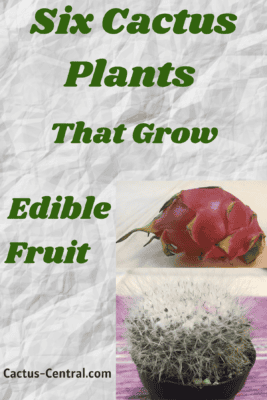
It is cultivated in Asia, Australia, the U.S., the Caribbean, and other parts of the world for its bright red fruit. You may even find Dragon fruit for sale in your grocery store.
The outer part of the fruit is bright red and leathery, and the inside has white flesh with many small black seeds (which are also edible). The fruit is oval in shape and can be as large as 4.5” by 3.5” in size.
It tastes sweet, but somewhat bland and its flavor is often compared to being something like a mixture of kiwi and pear.
I haven’t seen these cacti for sale at any of my local garden centers, but they can be found online. Amazon has several to choose from; this one is a potted plant (not a cutting) and it comes in a 4 inch pot.
Fun fact: The dragon fruit flowers at night and the flower only lasts one day. It also has spines like other cacti, but they are soft.
Old Lady Cactus, Mammillaria hahniana
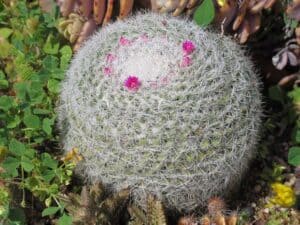
Old lady cactus’ often develop fruits on the top of their stems after blooming. These fruits are considered edible when they turn red. These fruits are described as having a sweet and tart flavor.
Overall, there won’t be many fruits found on each plant so it wouldn’t be worth growing this cactus just for the fruits.
If you already have an Old lady cactus, you might want to check out this article. It will explain what you can do to encourage your Old lady to bloom.
If you don’t have one yet, you can easily find one on Amazon. This one is a good choice; it comes as a potted plant (not a cutting).
Hedgehog Cactus, Echinocereus engelmannii

Hedgehog cacti are native to the Southern part of the U.S. and Mexico. Many varieties of these plants produce fruit that is edible.
Echinocerius engelmannii, also known as the Strawberry Hedgehog Cactus or Engelmann’s Hedgehog Cactus, is one of the varieties that produce edible fruit.
These cacti are low-growing plants and like to grow in clusters. They grow well as an indoor plant.
We mentioned the hedgehog cactus in our article called Top 8 Easy-to-Grow Cacti For Indoors. You can go there to learn more about Hedgehog cacti and other easy-to-grow cacti such as the Prickly pear cactus which is another edible cactus (mentioned below).
The fruits they produce are small, oval in shape and with a reddish-orange skin. The flesh inside the fruit is white and tastes very much like strawberries!
These fruits are often a food source for desert animals.
Indigenous peoples in the Southwest U.S. also used these fruits, often eating them raw, dried, or even turning them into a type of jam.
Prickly Pear, Opuntia ficus-indica
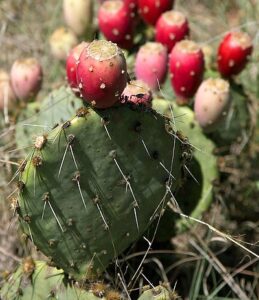
This is probably the first cactus most people think of when it comes to edible cacti. It is native to the Southern U.S. and Mexico. This is a very versatile plant. It not only is a decorative plant indoors in a pot, but it also can be a source of food for people.
I have seen some very large specimens growing in people’s backyards in California and for some of them, it was grown as a food source to supplement their meals.
The prickly pear fruit is called a “tuna”, or “nopal” or just plain “prickly pear”. It is oval in shape and can be around 2-4” in length. The fruit has glochids, which are hair-like spines that will hurt you, so precautions are needed when handling them.
Once you get past the skin and the glochids, the taste of the fruit can range from tart to sweet depending on the plant or the ripeness of the fruit. The sweetest fruit usually comes from the darker red to orange-colored fruit.
Overall, the taste is often compared to that of a watermelon with its pulpy flesh. It can be eaten raw, or made into jelly or jam or used in many other recipes.
In addition to the fruit, the prickly pears’ pads (also known as nopales), are also used for food. They are cooked and served as a vegetable.
If you can locate prickly pear fruit (tuna) in your local grocery store, you can try it out for yourself. You may also find prickly pear jelly or jam to try out too.
Barrel Cactus, Ferocactus Wislizeni
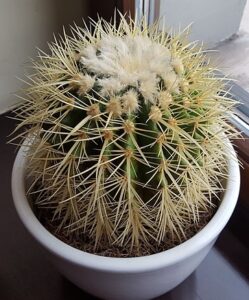
The Barrel Cactus, originating from North America, is also another cactus that can grow edible fruits.
The fruits are usually between 1.5 to 2” in length and are yellow or reddish when ripe. These fruits are usually only eaten when cooked and not raw since they are very sour. Its fruits are often used in jams and jelly.
Note: These fruits are high in oxalic acid so should not be eaten in large quantities.
The flowers and their buds are also edible and are usually cooked as a vegetable.
These plants are more commonly grown as an ornamental plant and are very well liked as an indoor cactus. Amazon has one here and it comes well-established.
Peruvian Apple Cactus, Cereus Peruvianus (also Cereus repandus)
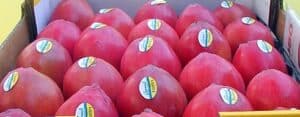
Peruvian apple cactus originates from the Southern U.S. and South America. It is commonly grown as an ornamental plant, but its fruit is edible. In fact, it is a cousin to the popular Dragon fruit that many people know about. (Which we have mentioned above).
Both of these plants are a type of “night blooming cereus” and have edible fruit. There are several other varieties of cactus that are also called night blooming cereus.
The Peruvian apple cactus is an upright cactus and can easily grow up to 33 feet high in the wild. In pots and planters they don’t get that high, especially with pruning.
Its large cream-colored flowers, when pollinated, form fruit which is very similar to the Dragon fruit. These fruits are rounded and the flesh is white with small black seeds. The fruit will split open when it is ripe.
The taste has been described as anything from slightly tart to sweet, very similar to that of the Optunia cactus fruit (Prickly pear).
This one was a little harder for me to find, but Amazon has this one here, if you are interested.
Conclusion:
There are several other types of cactus plants that are also considered edible and I plan to learn more about them since it is a very interesting topic.
As a precaution you should confirm with an expert before trying them out.
This post was written for cactus-central.com and is not permitted to be used on other sites.
